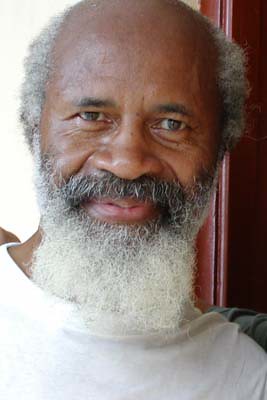Long Walk Home
Richard K. Yazzie, murallist, 2005
In 1864, during a period of destabilization among U.S. settlers, Spanish inhabitants and Native Americans, the Navajo and some Apachee were singled out by the U.S. government as responsible for raiding. Thousands of Navajo people were forcibly marched from Canoon de Chelly by Colonel Kit Carson, on orders of Brigadier Geeneral James H. Carleton, to Fort Sumner, 400 miles away. Eventually, 7,000 Navajo were imprisoned there.
The captives suffered four years of deplorable conditions of drought, hunger and cold until it no longer became feasible to hold them. The Peace Treaty of 1868 was signed and the Navajo were released. At Fort Wingate, livestock and other supplies were distributed. From there the Navajo dispersed allong the Rio Puerco, where Gallup was later founded in 1881, to their ancestral homeland, now a defined reservation.
Note: This is the kind of rainbow that I saw for the first time in my life, both ends in plain sight, as I entered Santa Fe about a week ago.
Monday, June 19, 2006
Sunday, June 18, 2006
Gallup, New Mexico
Women's Mullti-cultural Mural
Erica Rae Sykes, muralist, 2005
Centuries before Gallup's founding in 1881, this was a region of interweaving native cultures -- Navajo, Hopi and Zuni. Resources of coal, timber, railroads and trading attracted settlers and created a city of increasing cultural diversity.
We offer a tribute to the women who have carried on the traditions of daily life of their own cultures, raising children, making gardens and neighborhoods. Women who have perpetuated special holidays. Women who have had a major role in forming our cultural organizations, churches, schools and libraries.
The large symbolic storyteller at the left of the mural pays homage to the women who have kept multi-cultural memories alive by telling stories of the past.
[From the plaque by the mural]
Erica Rae Sykes, muralist, 2005
Centuries before Gallup's founding in 1881, this was a region of interweaving native cultures -- Navajo, Hopi and Zuni. Resources of coal, timber, railroads and trading attracted settlers and created a city of increasing cultural diversity.
We offer a tribute to the women who have carried on the traditions of daily life of their own cultures, raising children, making gardens and neighborhoods. Women who have perpetuated special holidays. Women who have had a major role in forming our cultural organizations, churches, schools and libraries.
The large symbolic storyteller at the left of the mural pays homage to the women who have kept multi-cultural memories alive by telling stories of the past.
[From the plaque by the mural]
Subscribe to:
Comments (Atom)


